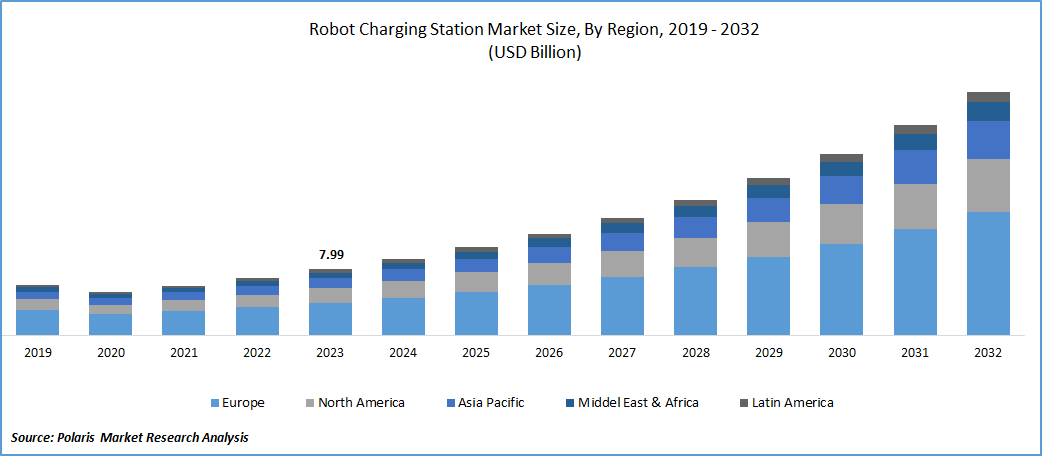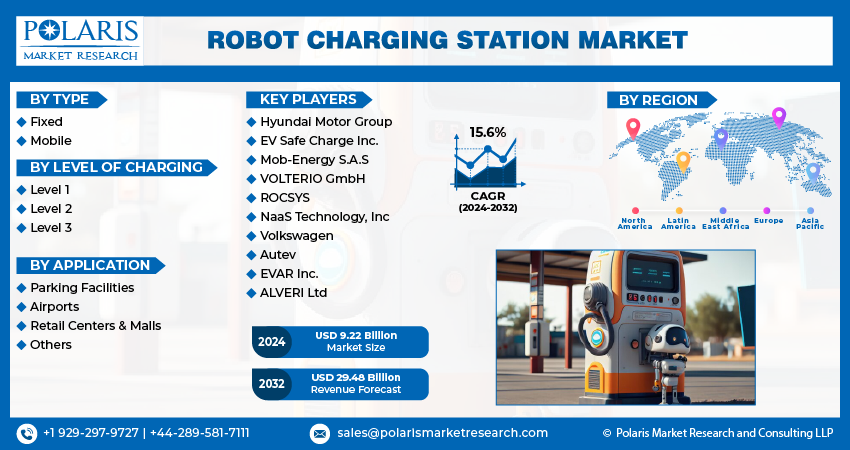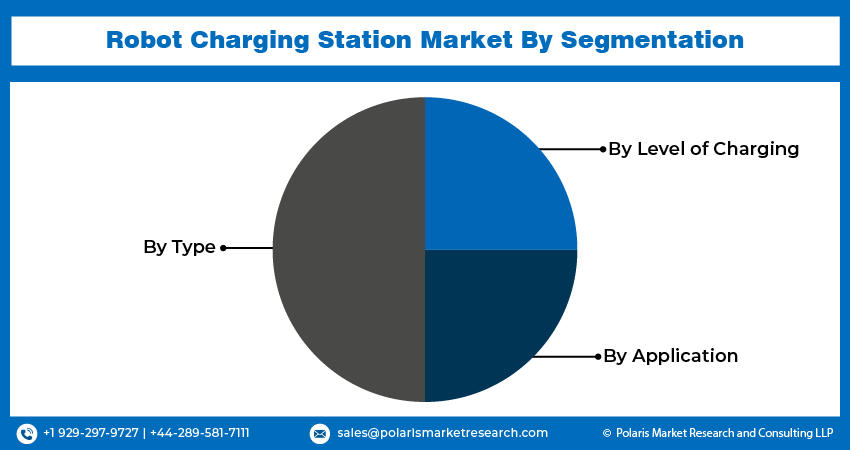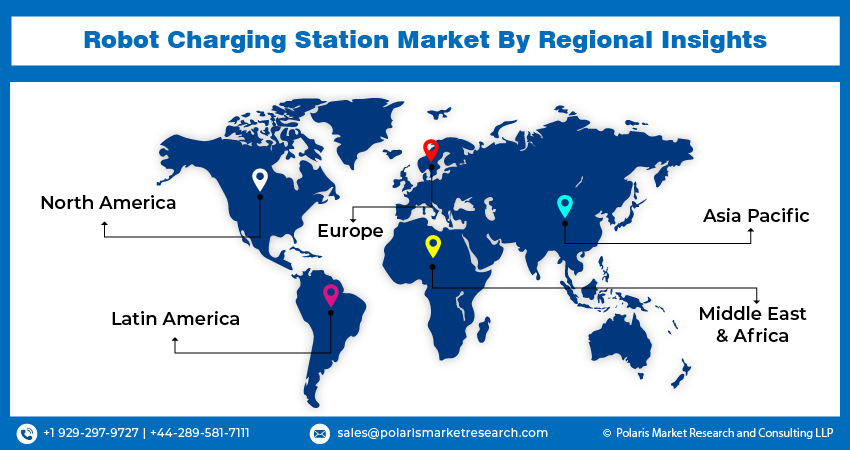
Robot Charging Station Market Share, Size, Trends, Industry Analysis Report, By Type (Fixed, Mobile), By Level of Charging, By Application (Parking Facilities, Airports, Retail Centers & Malls, Others), By Region, And Segment Forecasts, 2024 - 2032
- Published Date:Feb-2024
- Pages: 117
- Format: PDF
- Report ID: PM4259
- Base Year: 2023
- Historical Data: 2019-2022
Report Outlook
The global robot charging station market size and share was valued at USD 7.99 billion in 2023 and is expected to grow at a CAGR of 15.6% during the forecast period.
The market's expansion can be linked to the widespread adoption of electric vehicles (EVs) worldwide, driving the demand for innovative charging solutions. The focus on autonomous driving has also expedited charging infrastructure, leading to the incorporation of AI and ML algorithms for precise and efficient docking & charging processes. To meet the demand for seamless and convenient charging experiences, these advanced charging stations capable of independently locating & connecting to EVs have been developed. Additionally, investments in eco-friendly charging solutions, driven by efforts to enhance sustainability and reduce carbon emissions, are further propelling market growth.
The robot charging station market report details key market dynamics to help industry players align their business strategies with current and future trends. It examines technological advances and breakthroughs in the industry and their impact on the market presence. Furthermore, a detailed regional analysis of the industry at the local, national, and global levels has been provided.

To Understand More About this Research: Request a Free Sample Report
A notable trend in the market is the seamless incorporation of artificial intelligence and the pursuit of complete autonomy. Charging stations now feature sophisticated AI algorithms, enabling them not only to independently locate and connect to electric vehicles but also to adapt to varying environmental conditions. These intelligent solutions can optimize charging techniques by considering factors such as battery health, grid demand, and user preferences, enhancing the efficiency and user experience of the charging process. With the increasing adoption of electric vehicles, the demand for AI-driven robot charging stations is anticipated to rise, fostering innovation within this industry.
The sustainability factor of robot charging stations is becoming increasingly important as the world moves towards more eco-friendly transportation options. Manufacturers are prioritizing energy-efficient designs and materials to minimize the environmental impact of these stations. Furthermore, some charging stations incorporate renewable energy features like solar panels or wind turbines, enabling them to utilize clean energy sources for charging purposes. Energy management systems are also being employed to optimize charging schedules during low-demand periods, aiding in balancing grid loads and encouraging the efficient utilization of electricity.
The robot charging station market experienced moderate disruptions during the initial phase of the COVID-19 pandemic, marked by supply chain interruptions and manufacturing delays due to lockdowns and restrictions. However, as the pandemic continued, it accelerated specific trends in the market. The increased emphasis on contactless and touchless solutions, driven by health concerns, led to a significant rise in demand for autonomous robot charging solutions and systems. These systems, capable of conducting charging operations without human involvement, became popular due to their alignment with the need for minimized physical interaction.

Growth Drivers
Increasing Adoption of Robots:
Robot charging stations are advancing to accommodate multiple charging modes, catering to a diverse array of electric vehicles (EVs). This evolution involves the creation of robotic arms and adapters capable of accommodating various charging standards, voltages, and connector types. By ensuring compatibility with a wide range of EV models and charging infrastructure, these stations provide flexibility & accessibility, making the EV ownership more attractive to a wider audience base. Additionally, manufacturers are exploring the potential for wireless charging capabilities, enhancing convenience, and reducing physical wear on charging connectors.
Report Segmentation
The market is primarily segmented based on type, level of charging, application, and region.
|
By Type |
By Level of Charging |
By Application |
By Region |
|
|
|
|
TTo Understand the Scope of this Report: Speak to Analyst
By Type Analysis
Mobile Charging Segment Held the Largest Share
Mobile charging segment dominated the market. Mobile robot EV chargers, with their ability to move freely and service multiple vehicles across various locations, are gaining prominence in urban settings, parking facilities, and areas with high EV traffic. Unlike traditional fixed chargers, these innovative systems are agile and adaptable, autonomously navigating within specific zones. This mobility enables them to efficiently locate EVs requiring charging, reducing the necessity for dedicated charging stations. With the continuous growth in EV adoption, this trend highlights the significance of flexible and dynamic charging solutions that can cater to owners' evolving needs while optimizing space and infrastructure costs.
Fixed charging segment will grow at a significant pace. With the advancement of EVs, these stations are evolving to provide higher charging capacities. These stations are engineered to offer rapid & ultra-fast charging, drastically reducing the time needed to recharge an EV's battery. This development is in line with the increasing demand for quicker charging solutions, addressing the requirements of both individual consumers and commercial vehicle fleets.
Additionally, the emergence of modular and scalable charging infrastructure is becoming increasingly popular. Fixed robot charging stations are now crafted with modular elements that can be effortlessly expanded or upgraded to include more charging stalls. This adaptable approach enables charging station operators to respond to shifting demand patterns and optimize their infrastructure investments effectively.
By Level of Charging Analysis
Level 2 Segment Accounted for the Largest Market Share in 2023
Level 2 segment accounted for the largest market share. Level 2 chargers, recognized for their adaptability and moderate charging speed, are undergoing a transformation to meet the changing demands of electric vehicle owners. One notable trend is the incorporation of advanced connectivity features. These chargers now come equipped with enhanced connectivity options, allowing users to monitor and control the charging process remotely via mobile apps or web interfaces.
Level 3 segment will exhibit a robust growth rate. The surge in demand for ultra-fast charging solutions is a key driver behind this growth. Notably, these chargers are adopting higher charging power levels, pushing the limits of charging speed. Many of them incorporate liquid-cooled systems to handle the heat generated during rapid charging, ensuring the durability of both the charger and the battery. Additionally, a focus on modular and scalable infrastructure design enables charging station operators to effortlessly expand capacity, enhancing their flexibility in accommodating evolving needs.
By Application Analysis
Parking Facilities Segment Accounted for the Largest Market Share in 2023
Parking facilities segment accounted for the largest market share. Robot charging stations within parking facilities have undergone significant advancements, offering more than just charging services. They now come equipped with autonomous EV monitoring and maintenance capabilities. These stations can independently manage the charging requirements of multiple EVs.

Regional Insights
Europe Accounted for the Largest Share of the Global Market in 2023
Europe region witnessed the global market. The region's robust growth can be attributed to the rapid expansion of electric vehicle (EV) infrastructure, bolstered by proactive government initiatives promoting environmentally friendly transportation. Region's strategic investments in EV adoption are driving significant advancements in robot charging stations, emphasizing scalability and compatibility to meet the demands of the rapidly growing EV market. Moreover, technological and manufacturing innovations are facilitating the development of cost-effective and highly efficient robot charging solutions, making them more accessible to a broader range of consumers.
Asia Pacific will grow at a substantial pace. The region is witnessing a rise in local innovation, with indigenous companies customizing solutions to suit regional needs, fostering the development of a self-sufficient EV ecosystem. These charging stations are designed for adaptability, serving a wide range of EV models & charging standards.

Key Market Players & Competitive Insights
Industry is currently in its nascent stage and shows signs of consolidation, with a limited number of major players employing strategic methods to establish a strong foothold. This scenario presents obstacles for newcomers seeking to carve out their space in the market.
Some of the major players operating in the global market include:
- Hyundai Motor Group
- EV Safe Charge Inc.
- Mob-Energy S.A.S
- VOLTERIO GmbH
- ROCSYS
- NaaS Technology, Inc
- Volkswagen
- Autev
- EVAR Inc.
- ALVERI Ltd
Recent Developments
- In October 2023, BP's charging division, bp pulse, revealed plans to purchase ultra-fast charging hardware units from Tesla, making a significant investment of USD 100 Mn.
- In March 2023, NaaS Technology introduced an automated EV charging robot, representing a noteworthy advancement in the field of technology. This robot possesses the ability to autonomously detect vehicles, conduct charging procedures seamlessly, and process payments automatically.
Robot Charging Station Market Report Scope
|
Report Attributes |
Details |
|
Market size value in 2024 |
USD 9.22 billion |
|
Revenue Forecast in 2032 |
USD 29.48 billion |
|
CAGR |
15.6% from 2024 – 2032 |
|
Base year |
2023 |
|
Historical data |
2019 – 2022 |
|
Forecast period |
2024 – 2032 |
|
Quantitative units |
Revenue in USD billion and CAGR from 2024 to 2032 |
|
Segments Covered |
By Type, Level of Parking, Application, By Region |
|
Regional scope |
North America, Europe, Asia Pacific, Latin America, Middle East & Africa |
|
Customization |
Report customization as per your requirements with respect to countries, regions, and segmentation. |
Navigate through the intricacies of the 2024 robot charging station market with precision, thanks to the comprehensive statistics on market share, size, and revenue growth rate assembled by Polaris Market Research Industry Reports. This thorough analysis not only provides a glimpse into the historical context but also extends its reach with a market forecast outlook until 2032. Immerse yourself in the richness of this industry analysis by securing a complimentary PDF download of the sample report.
FAQ's
The global robot charging station market size is expected to reach USD 29.48 billion by 2032
Hyundai Motor, EV Safe Charge, Mob-Energy, VOLTERIO, ROCSYS, NaaS Technology, Volkswagen are the top market players in the market.
Europe region contribute notably towards the global Robot Charging Station Market.
The global robot charging station market is expected to grow at a CAGR of 15.6% during the forecast period.
The Robot Charging Station Market report covering key segments are type, level of charging, application, and region.
